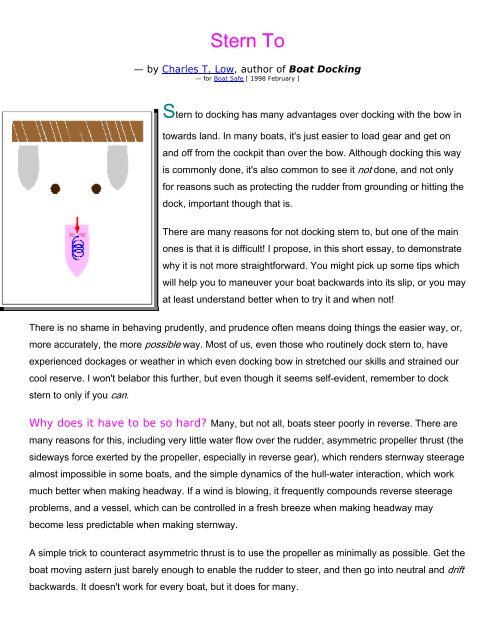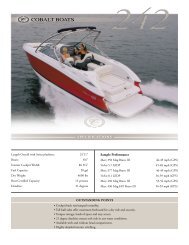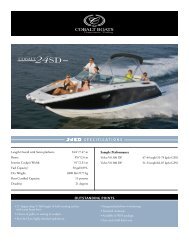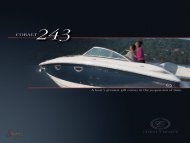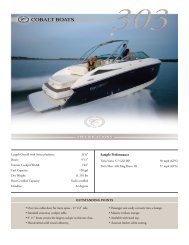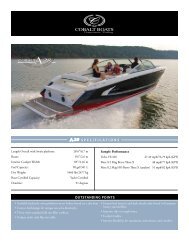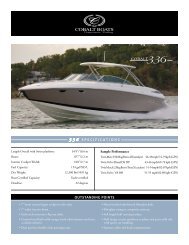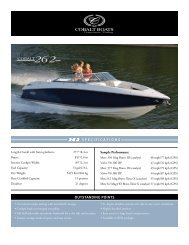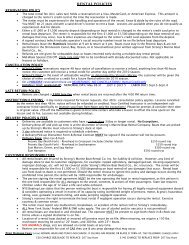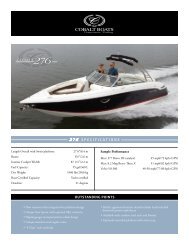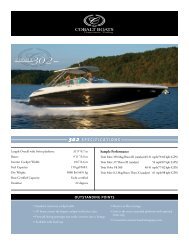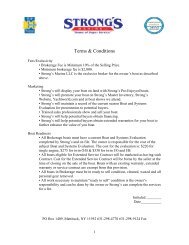Stern To Docking & Narrow Channel Maneuvering
Stern To Docking & Narrow Channel Maneuvering
Stern To Docking & Narrow Channel Maneuvering
- No tags were found...
Create successful ePaper yourself
Turn your PDF publications into a flip-book with our unique Google optimized e-Paper software.
<strong>Stern</strong> <strong>To</strong>— by Charles T. Low, author of Boat <strong>Docking</strong>— for Boat Safe [ 1998 February ]<strong>Stern</strong> to docking has many advantages over docking with the bow intowards land. In many boats, it's just easier to load gear and get onand off from the cockpit than over the bow. Although docking this wayis commonly done, it's also common to see it not done, and not onlyfor reasons such as protecting the rudder from grounding or hitting thedock, important though that is.There are many reasons for not docking stern to, but one of the mainones is that it is difficult! I propose, in this short essay, to demonstratewhy it is not more straightforward. You might pick up some tips whichwill help you to maneuver your boat backwards into its slip, or you mayat least understand better when to try it and when not!There is no shame in behaving prudently, and prudence often means doing things the easier way, or,more accurately, the more possible way. Most of us, even those who routinely dock stern to, haveexperienced dockages or weather in which even docking bow in stretched our skills and strained ourcool reserve. I won't belabor this further, but even though it seems self-evident, remember to dockstern to only if you can.Why does it have to be so hard? Many, but not all, boats steer poorly in reverse. There aremany reasons for this, including very little water flow over the rudder, asymmetric propeller thrust (thesideways force exerted by the propeller, especially in reverse gear), which renders sternway steeragealmost impossible in some boats, and the simple dynamics of the hull-water interaction, which workmuch better when making headway. If a wind is blowing, it frequently compounds reverse steerageproblems, and a vessel, which can be controlled in a fresh breeze when making headway maybecome less predictable when making sternway.A simple trick to counteract asymmetric thrust is to use the propeller as minimally as possible. Get theboat moving astern just barely enough to enable the rudder to steer, and then go into neutral and driftbackwards. It doesn't work for every boat, but it does for many.
Twin screws — Having and using the effects of twin screwscan be a real boon under these circumstances. Even twin screwshave limitations, but some vessels with them can even be made towalk sideways against a wind, given an experienced operator. I amgoing to leave the details for another time, and assume for themoment that you have a single-engine boat, as currently do I.Contrariness — Another problem to overcome is that of“contrary motion and propulsion” — in this instance, I'm talkingabout using forward gear while you're still going backwards.Forward gear is commonly used when making sternway (brieflyenough to allow the vessel to continue movement astern), firstlybecause steering is so much better in forward gear than in reverse(in many boats), and secondly as a means of putting on the brakes!However, it gets more complicated than that because the concepts and techniques for “contrarysteering” are completely different depending upon whether you're making sternway and then puttingthe boat into forward gear, or making headway and putting the boat into reverse gear. Again, I thinkit's too much to get into all of the niceties just now — we may get around to it eventually, and it's all inthe book, but at least know that there's something to know!Inboard or Outboard? For steerage astern, would you rather have an inboard or an outboardengine? (Inboard/outboards are classed with outboards in terms of their steering mechanics.) Well,both propulsive designs have advantages and disadvantages, and for every boater who is sure he orshe knows which one is best, another has a considered and differing position. In this instance,however, I vote for the outboard, because being able to actually swing the propeller itself from side toside affords better reverse gear steerage (acknowledging that there are always exceptions) than doesa rudder. Do not construe this to mean that I prefer inboards, or outboards, or rowboats, or anything.My comments relate very narrowly to docking stern to.Keels — Even more to the point, would you rather have a boat with or without a substantial externalkeel? As usual, there are pros and cons. For example, sometimes a full keel exacerbates the effectsof asymmetric propeller thrust. Just as often, however, it allows the hull to track straight and true, andto tolerate a cross wind better, so in general, a boat with a keel will back into a slip better.
What to do? One solution for all of these things, as I mentioned above, is simply not to do it! Go inforwards. Many boating experts never dock stern to, or they maneuver the boat only partly into itsslip, and walk it the rest of the way in by hand. However, without going into all of the technical details,some of which have been discussed in this space before and some of which are planned for thefuture, another approach is to learn more about your boat. Practice backing into slips, starting in calmweather some place where there is lots of room for error. My hope is that it will be more rewardingand less frustrating for you if you at least know what you're up against, and why the boat doesn't justback up in a straight line when you engage reverse gear.So, when practicing sternway boat steering, consider all of the things we have touched upon: poorreverse steerage, asymmetric propeller thrust, adverse hull dynamics, wind, and contrary motion andpropulsion. If you ever get it all figured out, please let me know, because I think you will be the first —this can be tricky, and I have met no one (myself definitely included) who couldn't still hone their skillsa little more.Conclusion — With practice and training, most boaters find that they rebel against their boats'idiosyncrasies less and less, and learn to anticipate them and actively use them more and more. Theboat may not, not back up in a straight line, but you will learn how it does behave, and how it doesrespond to control inputs, and you will increase the likelihood of joining the elite club of “stern todockers”.
How to Maneuver in <strong>Narrow</strong> <strong>Channel</strong>s"Back and Fill"The proper name of the maneuver in question is "Back and Fill". Theexecution of the maneuver depends on whether or not you have a righthand screw (turns clockwise in forward) or left hand screw (turnscounterclockwise in forward). For our example we will assume a righthand, single screw boat. We will also assume favorable conditions i.e.lack of significant wind and/or current. Using the following method youshould be able to turn a single screw boat in slightly more than itslength.You should start the maneuver at idle speed toward the left side of thechannel (figure 1.).When ready to turn, put the rudder hard to starboard. As the bowbegins to turn (figure 2.).Shift to reverse which will, because of the prop walk, start the sternmoving to port (figure 3.).Once you have checked forward momentum, but not the momentum of the bow movement,shift back to forward (figure 4).The bow will continue to smoothly turn around the pivot point. One more shift to reverseshould complete the turn (figure 5.).You do not want to make headway or sternway but simply pivot with a continuous motion.It may take more forward and reverse shifts than the graphic illustrates to continue pivotinguntil you have made the 180º turn and are headed out of the channel (figure 6.).Important Notes:• Keep the rudder hard to starboard at all times.• Stop for a brief second in neutral between shifts.• Only stay in gear long enough to continue the pivoting motion, notlong enough to gather headway or sternway.• If you have other than ideal conditions, you may need to use a quickand short burst of throttle to help push the bow and stern around.• With a left hand screw boat you would do the procedure in thecompletely opposite direction, i.e. start on right side, and rudder hardto port.A side note from Bob Reardon, "Many down-east or lobster-type boats have left handed props. This is areason: Working lobster boats usually have a working helm aft on the starboard side. Backing to starboardmakes their life easier."www.BoatSafe.com


